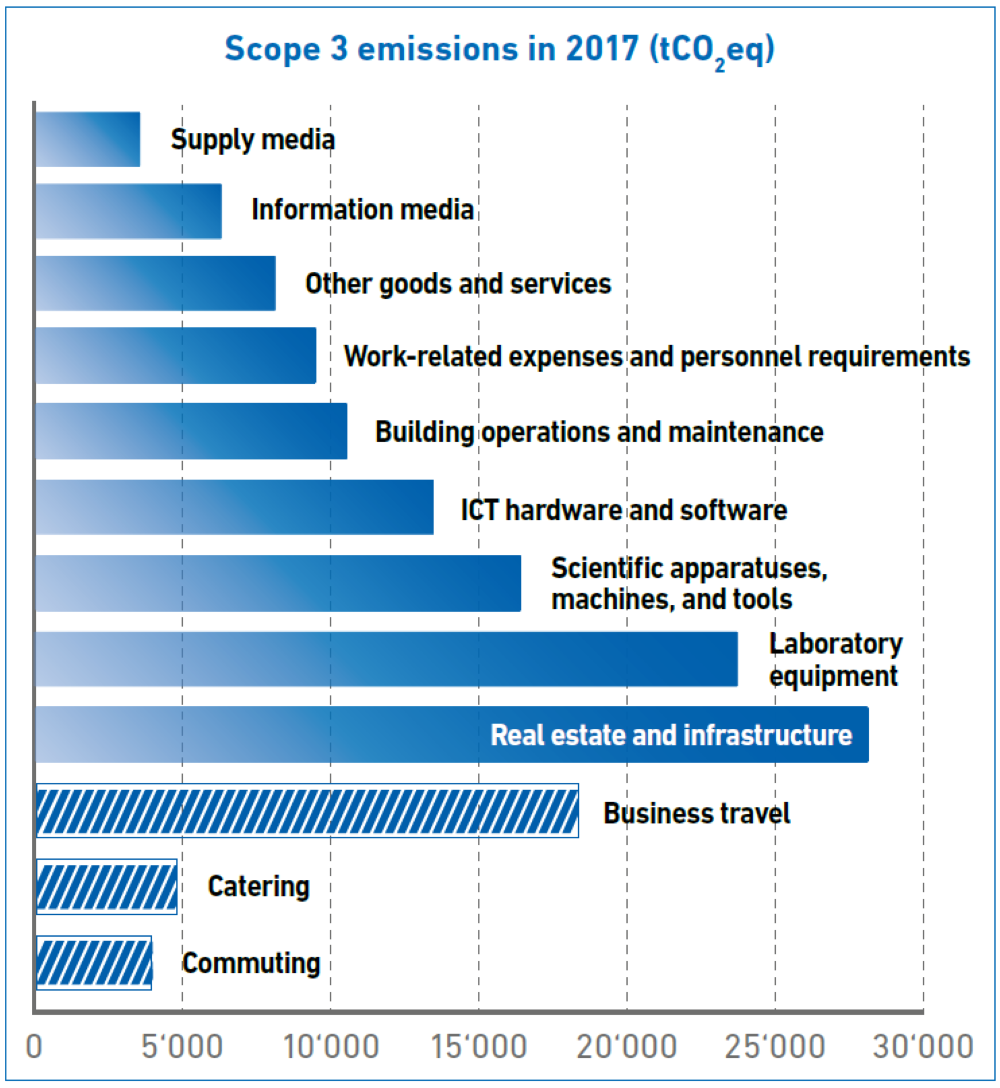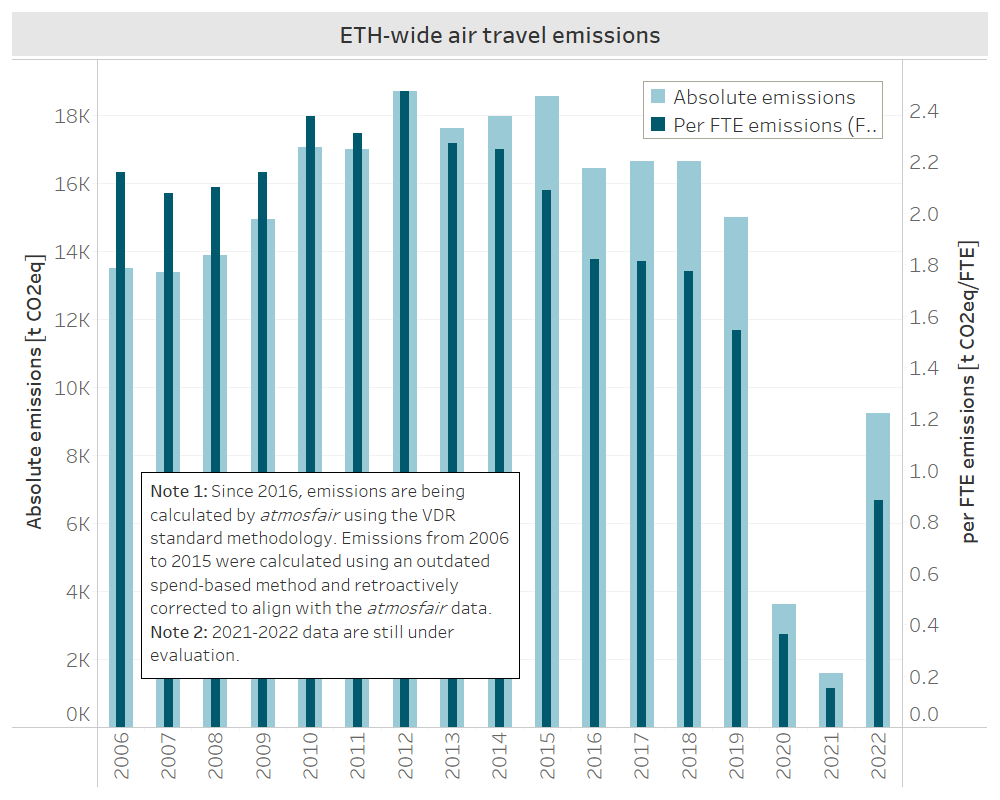The ETH Air Travel Project - Achieving more data transparency through data stewardship
After a hiatus of roughly two years due to the global Covid-19 pandemic, air travel ramped up again in 2022 - also at ETH Zurich. This can be observed - among other exciting results on flight behavior at ETH - on the new air travel emissions dashboard on the updated air travel website.

The ETH Air Travel Project - an important tool for reducing greenhouse gas emissions at ETH Zurich
In 2017, ETH Zurich became one of the first universities worldwide to launch a university-wide project with specific departmental targets for reducing emissions from business travel. The goal of the ETH Air Travel Project is to pursue a reduction path that is compatible with scientific excellence and the best possible career opportunities for researchers, while contributing to a measurable reduction in the university's greenhouse gas emissions. The project was initiated, developed, and until 2021 managed by Susann Görlinger in the former Office of the Vice President for Personnel and Resources. Since the beginning of 2022, the Air Travel Project is part of the portfolio managed by ETH Sustainability and thus centrally located in the Office of the President.
Since its inception six years ago, the Air Travel Project has sparked a lively dialogue throughout the ETH community about alternatives to flying and new forms of exchange and formats for conferences, work meetings and other types of events. It has also led to the formulation of concrete reduction targets and - at some departments - to the introduction of internal CO2 tax systems.
Why is monitoring air travel emissions at ETH Zurich relevant?
The cornerstone of the ETH air travel project is the flight-specific, quantitative emissions data, which make up a significant part of ETH's greenhouse gas emissions and have been recorded since 2006. This means that ETH has one of the longest data series on academic air travel by international comparison. This can be interpreted as an expression of competence, but also as an incentive to act correspondingly ambitiously and to be a pioneer in the field of flight behavior as well as in research and innovation in the aviation industry.
The data dashboard on the updated air travel website allows ETH air travel emissions to be explored in an aggregated form and within a deliberately small selection. The new website also outlines the concept of Data Stewardship developed by ETH Sustainability in 2022 for the processing, management and monitoring of ETH air travel emissions data. This is a three-pronged approach involving the units ETH Sustainability, Institutional Research and the Competence Center SAP, the latter two from the Controlling department. The goal of the approach is to make the air travel emissions data more easily accessible and viewable for ETH affiliates and the general public in the spirit of data transparency and openness and to promote the concepts of data sharing and open research data.
In this way, the air travel emissions data can be related to other reduction and efficiency targets on campus and in research and teaching operations and form an essential monitoring element of the reduction path towards ETH Zurich's net zero target. As outlined in the white paper "ETH Zurich strives for Net Zero by 2030", ETH Zurich aims to meet the targets of the 2019 federal climate package (“Klimapaket”) with regard to its greenhouse gas emissions. In concrete terms, this means that the university has set itself the goal of achieving zero net emissions by 2030. It aims to accomplish this by reducing its emissions by at least 50% compared to the 2006 reference year and credibly offsetting the remainder to reach net zero.
Explore the ETH Air Travel Project website!
The ETH Air Travel Project website has been updated to include an interactive data dashboard that allows visitors to visually explore ETH's air travel emissions from 2006 to present. The website also contains information about the newly created concept of data stewardship for ETH air travel emissions, decision support for choosing modes of transport for business trips or for virtual partici-pation in conferences, as well as background information on the project and supporting research.
Business travel - a sector on which all ETH members have a major influence
To ensure that the data monitoring and reporting of emission values is based on as uniform a data basis as possible, ETH Zurich uses the three emission types (so-called "scopes") according to the Greenhouse Gas Protocol. Scope 1 refers to direct emissions from ETH-owned buildings and vehicles and Scope 2 to indirect emissions from purchased electricity and district heating. Scope 3 includes all indirect emissions that are hidden in the upstream and downstream value chains of the products and services consumed. Business travel is included in Scope 3 emissions.
In 2017, ETH Zurich's Scope 3 emissions amounted to about 140,000 tons of CO2 equivalents (tCO2eq), ten times larger than Scope 1 and 2 emissions combined (Stolz and Frischknecht, 2019[1]). Emissions from business travel at ETH, of which air travel accounts for about 93% (see Download Sustainability Report 2019/2020 (PDF, 13 MB), page 66), are estimated to be more than twice as large as Scope 1 and 2 emissions combined and account for about 13% of the total Scope 3 emissions (Fig. 1).
Business travel thus accounts for the third largest share of total Scope 3 emissions and - more importantly - it exhibits a key characteristic: All students and employees at ETH can directly influence the emissions of this category by changing their travel behavior.

Using data transparency to achieve stricter reduction targets
In a participatory process in 2019, all 16 ETH departments and some central units set themselves reduction targets for air travel emissions per full-time equivalent (FTE) of between 5% and 50%, in relation to the baseline years 2016-2018. The ETH-wide reduction target of 15% was derived as an average of the individual targets. At the time, the year by which these reductions were to be achieved was set as 2025.
After emissions per FTE had already decreased by about 20% in 2019 relative to the baseline years, the two pandemic years (2020 and 2021) complicated and delayed a meaningful analysis. Even though ETH employees had flown significantly less during the Corona crisis, ETH-wide emissions per FTE increased again last year to about 50% of the value of the baseline years (Fig. 2). While this represents a reduction compared to the baseline years, it is not yet clear whether this reduction is merely a lingering effect of the pandemic or an actual reduction due to the success of the Air Travel Project.
The effect of reducing greenhouse gas emissions through more climate-friendly mobility behavior in the business travel sector of ETH is immediate and substantial. With the transparency of air travel data and the goal of reducing ETH-wide emissions by at least half by 2030, it is possible to quantify values in the form of greenhouse gas budgets. Such an approach adds a clear organizational objective to the previously voluntary approach, from which more consistent behavior and more commitment can result. It is already becoming apparent that the current ETH-wide reduction target of 15% by 2025 is no longer sufficient and that more ambitious targets must be set in all departments and units. The ETH Air Travel project continues to provide an optimal framework and support for associated negotiation processes.

[1]Stolz and Frischknecht. 2019. Scope 3 greenhouse gas emissions of ETH Zurich. Treeze Ltd. Uster, CH, commissioned by ETH Zurich. Unpublished.
Additional information
Always up to date
Would you like to always receive the most important internal information and news from ETH Zurich? Then subscribe to the "internal news" newsletter and visit Staffnet, the information portal for ETH employees.
Comments
No comments yet